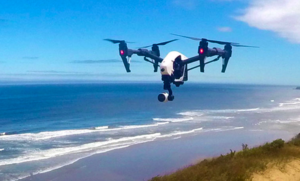
Capt. Brian Taggart, National Oceanographic and Atmospheric Institute (NOAA) (ret.) has spent a career flying all types of aircraft – manned and unmanned – to gather aerial data for conservation. Now, he heads the Oceans Unmanned project, an organization developed to use drones to support conservation, education and protection of oceans. Oceans Unmanned, says Taggart, is “Bringing Tech to Ocean Protection.”
“Drones are fundamentally changing the way we monitor and manage our environment,” says Taggart. With drones and mapping software (they partner with DroneDeploy), Oceans Unmanned is able to perform a stunning array of services to help conserve marine environments.
Oceans Unmanned is working with teams to track distribution and abundance of species – everything from whales to sea otters – with drones. They help identify whales that have been become entangled in fishing gear. They map and model shipwrecks, and marine heritage areas – places that might be too shallow to evaluate from a boat. They help to identify illegal fishing activity, which acts as a powerful deterrent. And they’ve counted and monitored human use of conservation areas also.
Recent technologies have been critical in advancing the work. Artificial intelligence that helps count species, new sensors, and sensor fusion have all provided major steps forward. New payloads allow scientists and environmentalists to get incredibly close to species, who can remain undisturbed: “They have no idea we are flying right above them,” says Taggart, showing a close up image of marine birds.
Oceans Unmanned has also created some best practices, in partnership with industry leaders, for operating recreational drones around wildlife. The “ECO-Drone Guide” (ECO stands for “environmentally conscious operations”) helps drone operators to understand how to limit their effect on the environment.
Bureaucracy, difficult geographic areas, and some technical limitations – like battery life – create challenges for teams using unmanned technology for ocean conservation. But the capabilities are extraordinary, says Taggart, who remembers his father flying in the very back of older aircraft to gather marine conservation data: “We’ve come a long way.”

Miriam McNabb is the Editor-in-Chief of DRONELIFE and CEO of JobForDrones, a professional drone services marketplace, and a fascinated observer of the emerging drone industry and the regulatory environment for drones. Miriam has penned over 3,000 articles focused on the commercial drone space and is an international speaker and recognized figure in the industry. Miriam has a degree from the University of Chicago and over 20 years of experience in high tech sales and marketing for new technologies.
For drone industry consulting or writing, Email Miriam.
TWITTER:@spaldingbarker
Subscribe to DroneLife here.